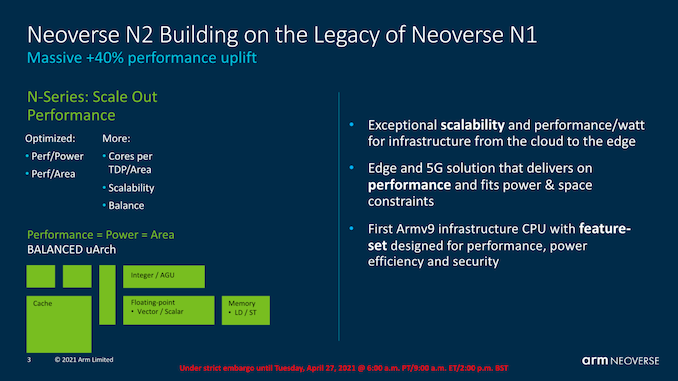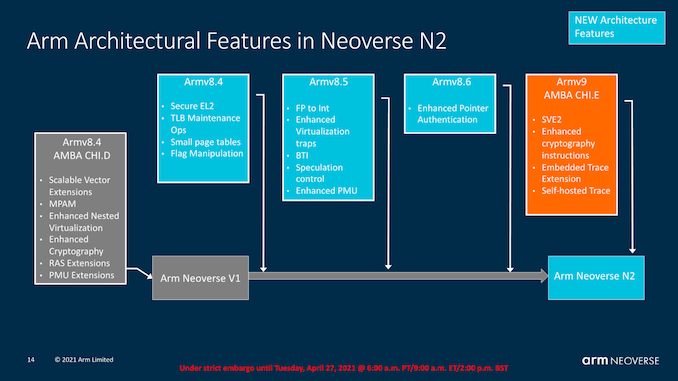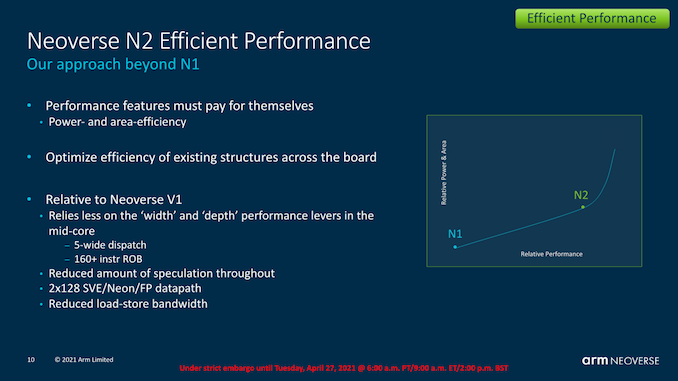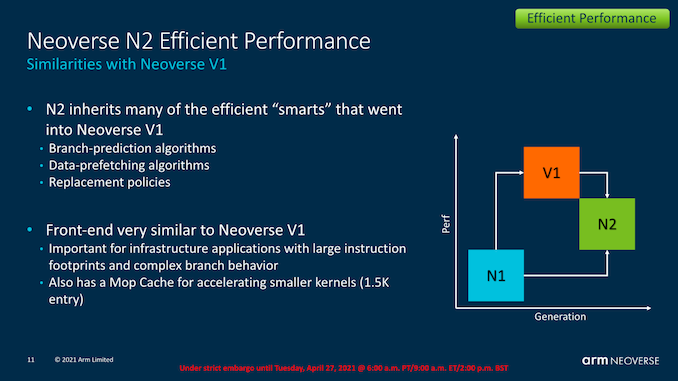Arm Announces Neoverse V1, N2 Platforms & CPUs, CMN-700 Mesh: More Performance, More Cores, More Flexibility
by Andrei Frumusanu on April 27, 2021 9:00 AM EST- Posted in
- CPUs
- Arm
- Servers
- Infrastructure
- Neoverse N1
- Neoverse V1
- Neoverse N2
- CMN-700
The Neoverse N2 µArch: First Armv9 For Enterprise
Moving from the performance oriented Neoverse V1 to the more balanced Neoverse N2 core, we’re seeing a different approach to performance, more akin to the Cortex-A78’s PPA focus versus the X1’s performance focus.
Arm makes note of the “balance” keyword here – the microarchitecture only adopts features and design changes if those changes actually contribute to an increase of the PPA (Performance, Power, Area) equation of the IP. In contrast, the V1 would opt for performance increasing features even if that meant a disproportionate increase in power and area, reducing the total PPA of the design.
Architecturally, the N2 is a newer core than the V1 and takes a higher architectural baseline as the foundation of its capabilities. It’s Arm’s first disclosed Armv9 capable core, including important new features such as SVE2. It’s to be noted that although Arm talked a lot about Armv9 CCA (Confidential Compute Architecture) last month, the Neoverse N2 core does not feature this capability, which is an extension we’re told to expect in future microarchitecture designs.
Arm’s microarchitectural disclosures on the N2 were rather limited compared to the details we’ve seen on the V1. This being a sibling core to the yet undisclosed next generation Cortex-A78 successor, we’ll have to wait a few more months to see exactly what differentiates this newer iteration compared to the Cortex-A78, besides the notable Armv9 features and new SVE2 pipelines.
Arm at least confirms that it’s a narrower microarchitecture in the sense that there’s only a 5-wide dispatch (compared to 8-wide in the V1), and the design features 2x128b native SVE2 and NEON pipelines.
The company states that the new design should still achieve an impressive +40% increase in IPC compared to the Neoverse N1, which is actually substantial given the fact that we’re promised only a linear increase in power and area.
In terms of “smarts”, or better said, microarchitectural innovations, the N2 is a super-set of the V1, just with a more conservative approach to block and structure sizes.
System side features, on top of MPMM and DT, PDP, or Performance Defined Power Management is a feature newer to the N2 that promises to vary the CPU’s microarchitectural features depending on workloads, in order to reduce power consumption without impacting performance. I imagine here that we’re talking about smarter workload dependent clock-gating of microarchitectural features, for example narrowing of the execution resources in low-IPC workloads.

















95 Comments
View All Comments
mode_13h - Tuesday, April 27, 2021 - link
> sample in the second half of 2022Uh, that means new machines won't be using them until at least the end of next year. And if we want more cores than an ultraportable, it's still no good.
Raqia - Wednesday, April 28, 2021 - link
I wouldn't put it past them to do a desktop or server sized SoC eventually if they have a great in house core design that isn't a commoditized IP block that anyone can license from ARM. It would give them an advantage at the higher tiers of performance that they will want piece of for sure.They also seem to be devoted to providing an open ARM computing platform in working with Linux developers and Windows when compared with Apple. That they added a hypervisor to the 888 should give you some indication to their future compute ambitions...
mode_13h - Wednesday, April 28, 2021 - link
> I wouldn't put it past them to do a desktop or server sized SoCThe already tried this, but their investors killed it. Lookup "Centriq". Building out a whole server infrastructure & ecosystem takes a lot of investment, and now they'd have established competitors with a multi-year lead.
Raqia - Wednesday, April 28, 2021 - link
I wasn't talking about servers (at least not right away), more consumer oriented and workstation scale compute. Amon did say that the designs they had in mind with Nuvia were "scalable" and that they were going to be addressing multiple markets.mode_13h - Wednesday, April 28, 2021 - link
I hope you're right. If anyone can compete with Apple right now, it's probably Nuvia/Qualcomm.name99 - Thursday, April 29, 2021 - link
You need three things to create a higher performance core than Apple- designers (check)
- an implementation team (hmm. maybe? this means *enough* good people and superb simulation/design tools)
- management willing to pay the costs [design costs, and willing to accept a substantially larger core] (hmmmmmmmm? will they chicken out and assume no-one is willing to pay for such a core, they way they always have for watch, phone, then centriq?)
And Apple won't stand still...
mode_13h - Tuesday, April 27, 2021 - link
> so far except the HPE's A64FXGigabyte makes Altra motherboards and servers that I'm sure you can buy for less than a HPE A64FX-based machine.
And, if you're counting A64FX as a "consumer machine", you ought to include Avantek's Altra-based workstations that I mentioned below.
mode_13h - Tuesday, April 27, 2021 - link
> if these CPUs outperform the EPYC Milan technically AWS should replace all of them right ?No, because a lot of people are still stuck on x86. Also, Amazon could be fab-limited, like just about everyone else. The sun might be setting on x86, but it's still a long time until dark.
Rudde - Tuesday, April 27, 2021 - link
An Avantek Ampere workstation might be available in a stand-alone system. Andrei expects Ampere to include N2 in their next gen systems instead of V1. Apple might also launch something in that segment in the coming years.mode_13h - Tuesday, April 27, 2021 - link
A UK-based company called Avantek makes Ampere-based workstations. Their eMAG-based version was reviewed on this site, a couple years ago, and they now have one with Altra. So, I'd say better than average chances we might see one with a V1-based CPU by maybe the end of the year or so.